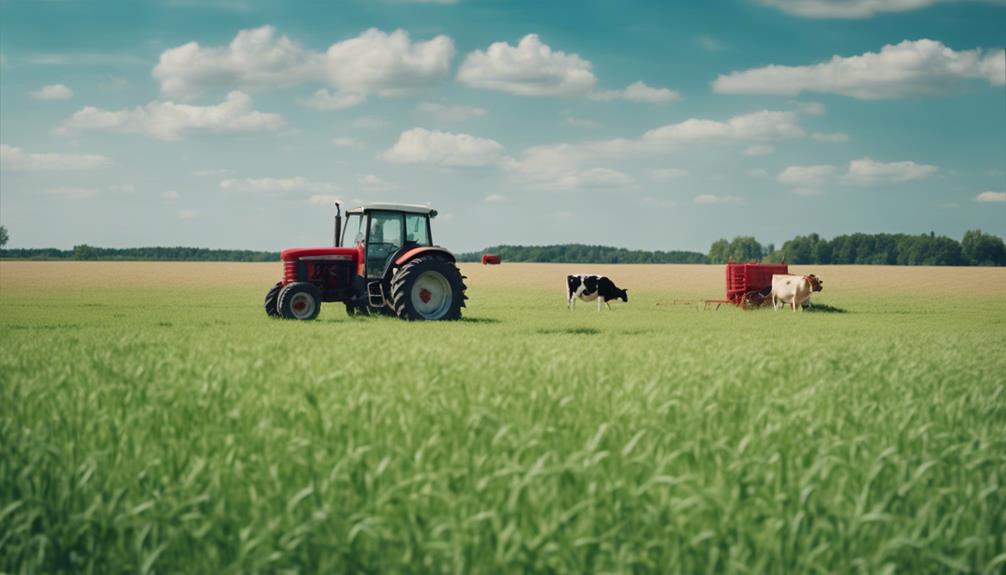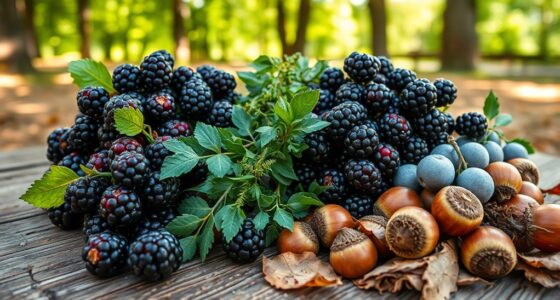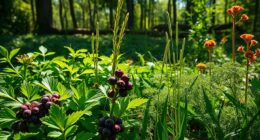You can effectively mow buck forage oats to improve their nutritional value, enhance soil health, and promote tender new growth, making them an attractive food source for deer and a valuable component of a thriving ecosystem. Mowing at the right height and frequency encourages healthy regrowth, reduces weed presence, and enhances soil fertility. By following best practices, you can maximize deer attraction, habitat quality, and overall ecosystem health. Continue to discover the ideal mowing patterns, equipment selection, and maintenance tips to guarantee a flourishing habitat that supports deer well-being and attracts them to your land.
Key Takeaways
- Mow Buck Forage Oats at 2-3 inches height to promote healthy regrowth and enhance soil fertility.
- Mow during moderate weather conditions, avoiding extreme heat or dryness, to optimize soil health and deer attraction.
- Leaving oats uncut in clover crops provides deer cover, while mowing promotes tender new growth and enhances wildlife habitat.
- Choose the right mower, such as a flail mower or brush hog, and maintain equipment regularly for efficient and effective mowing.
- Alternating mowing patterns and post-mowing maintenance, including raking and monitoring soil moisture, support even growth and deer health.
Understanding Buck Forage Oats
When you're looking to create a high-quality food plot, Buck Forage Oats are an excellent choice, thanks to their exceptional forage production and ability to thrive under heavy grazing pressure.
As a specialized winter oat variety, they're specifically bred to produce high-quality forage in large quantities, making them ideal for attracting deer and other wildlife to your food plot.
To get the most out of your Buck Forage Oats, it's crucial to plant them at the right rate. The recommended planting rate is 100 pounds per acre, or 50 pounds per acre when mixed with forage peas. Planting in the fall or spring at a seeding depth of about 1/2 inch will also ensure optimal growth.
By understanding the unique characteristics and planting requirements of Buck Forage Oats, you can create a thriving food plot that will attract wildlife all season long.
With their exceptional forage production and ability to withstand heavy grazing, Buck Forage Oats are an excellent addition to any food plot. They are specifically bred to be cold-tolerant, thriving in a variety of climates, which ensures a consistent food source for wildlife even during harsh conditions. The forage oat lifespan is notable, as these oats continue providing high-quality nutrition throughout the cooler months. Their resilience and nutrient-rich nature make them a popular choice for managing and supporting healthy deer populations. In addition to their cold tolerance, Buck Forage Oats are highly palatable, ensuring that deer and other wildlife are attracted to the food plot throughout the season. Their impressive **forage oat lifespan** means that land managers can rely on them to provide sustenance well into late fall and winter when other food sources may be scarce. This longevity makes Buck Forage Oats a dependable component of a diverse wildlife nutrition strategy.
Benefits of Mowing Buck Oats

As you explore the advantages of mowing buck oats, you'll discover that this practice can greatly enhance the quality of your forage.
By mowing, you can improve the nutritional value of your oats, boost forage yield, and even promote healthier soil.
Let's take a closer look at how mowing can lead to improved livestock nutrition, increased forage yield, and enhanced soil health.
Improved Livestock Nutrition
Mowing buck forage oats at the right time can greatly enhance the nutritional value of your livestock's feed, promoting healthier and more productive animals. By doing so, you can improve the palatability of the oats, making them more appealing to your livestock.
Regular mowing stimulates regrowth, which in turn improves the overall quality of the oat crop.
Here are three key benefits of mowing buck forage oats for improved livestock nutrition:
- Tender new growth: Mowing promotes tender new growth, which is more nutritious and easier for your livestock to digest.
- Reduced weed presence: Mowing helps control broadleaf weeds in the oats field, reducing the risk of weeds competing with your oat crop and enhancing overall livestock health.
- Best grazing conditions: Proper timing of mowing ensures the best conditions for your livestock to graze on the fresh regrowth of oats, providing them with the best possible nutrition.
Increased Forage Yield
By regularly mowing your buck forage oats, you can increase the overall forage yield, providing your livestock with a more abundant and nutritious food source. This is because mowing promotes tender new growth, which in turn boosts the overall yield. Timing is essential, though – aim to mow when the weather isn't too hot and dry, as this can damage the crop.
Last week, you may have noticed that your buck oats were getting a bit too tall; by mowing them, you got one more chance to promote healthy growth and increase the yield. Pretty much every farmer wants to maximize their harvest, and mowing buck oats is a simple yet effective way to do so.
Enhanced Soil Health
You'll find that regularly mowing your buck forage oats also has a profound impact on the health of your soil. By doing so, you've got a chance to create a more favorable environment for your crops to thrive.
Here are a few ways mowing can benefit your soil:
- Reduced weed growth: Mowing can help control broadleaf weeds that compete with your oats for resources, allowing your crops to grow stronger.
- Soil enrichment: When you mow, the decomposing oat stalks contribute to soil enrichment over time, making your soil more fertile and conducive to growth.
- Healthier clover growth: If you've got a mix of oats and clover, mowing can promote new growth in clover, attracting deer and other wildlife.
Ideal Mowing Height and Frequency

As you plan to mow your Buck Forage Oats, aim to cut them at a height of 2-3 inches to promote healthy regrowth and prevent weed competition. This ideal mowing height allows your oats to recover quickly and reduces the likelihood of weeds taking over.
When deciding on the frequency of mowing, consider the weather conditions. Avoid mowing during extremely hot and dry periods, as this can stress the oats and hinder their growth. Instead, mow when the weather is moderate, and the oats are more likely to respond positively.
Remember, mowing your Buck Forage Oats can have benefits beyond just weed control. It can promote tender new growth in clover, attracting deer and other wildlife. Additionally, the oat stalks left after mowing will decompose over time, enriching the soil for future plantings.
Timing Is Everything for Deer

When it comes to attracting deer to your Buck Forage Oats, timing your mowing to coincide with their natural habits and preferences can make all the difference. You want to create an environment that appeals to their instincts, providing them with the food and shelter they need to thrive.
To achieve this, consider the following key timing factors:
- Avoid extreme weather: Mow when the weather isn't too hot and dry, as this can help maintain crop quality and prevent damage.
- Respect their habitat: Leave oats uncut in a clover crop, as this provides deer with essential cover and food sources.
- Plan for the future: Time your mowing to support fall planting efforts and enhance wildlife habitat, setting the stage for a thriving ecosystem.
Promoting Healthy Regrowth Cycles

By mowing your Buck Forage Oats at the right time, you stimulate new growth, which in turn promotes healthy regrowth cycles and enhances the overall quality of your crop. Timing is essential, as mowing when the oats are too hot or dry can hinder regrowth. Leaving oats uncut can also benefit wildlife, providing food and cover, especially when part of a clover crop.
To guarantee ideal regrowth, consider the following factors:
| Factor | Effect on Regrowth | Ideal Condition |
|---|---|---|
| Moisture | Inhibits regrowth if too dry | 20-30% soil moisture |
| Temperature | Inhibits regrowth if too hot | 65-75°F (18-24°C) |
| Weather | Favors regrowth after rainfall | 1-2 inches of rainfall |
| Soil | Enriches soil for future growth | Well-draining, fertile soil |
Managing Weed Growth Effectively

To ensure healthy regrowth cycles, it's crucial to manage weed growth effectively in your Buck Forage Oats fields.
You'll want to explore different weed suppression methods, including the strategic use of herbicides, to prevent weeds from competing with your crops.
Weed Suppression Methods
For effective management of weed growth in your Buck Forage Oats fields, you'll want to explore a combination of methods that work together to suppress weeds and promote a healthy crop. This multi-faceted approach is essential for maintaining the quality of your oat crop and supporting wildlife habitat.
Here are some key weed suppression methods to explore:
- Herbicide application: Target specific weed species with tailored herbicide application, providing cost-effective control.
- Mowing: Regular mowing can help suppress weed growth, especially when combined with other methods.
- Crop management: Implementing best practices in crop management, such as recommended seeding rates and fertilization, can also help suppress weeds.
Effective Herbicide Use
You can take a targeted approach to weed management by selecting herbicides that effectively control specific weed species in your buck forage oats fields. This approach helps maintain the quality and quantity of your oat crop.
Consider using herbicides like clethodim to effectively control weed growth. By tailoring your herbicide application to target specific weed species, you'll achieve ideal results in weed control. This method can be a cost-effective alternative to manual weed management methods like mowing.
Effective weed management through herbicide use also supports a healthier habitat for wildlife. By managing weeds, you'll promote a more balanced ecosystem. Remember, effective herbicide use is key to maintaining a healthy and productive buck forage oats field.
Choosing the Right Mowing Equipment

When it comes to choosing the right mowing equipment for your Buck Forage Oats, selecting between a flail mower and a brush hog largely depends on the type of cut you're after. If you're looking for a finer cut and want to mulch the residue, a flail mower is the way to go. On the other hand, if you need to rough-cut your Buck Forage Oats, a brush hog is the better choice.
Here are a few things to keep in mind when choosing your mowing equipment:
- Mowing height: Adjust the mowing height to leave a stubble for wildlife cover and regrowth.
- Equipment maintenance: Regular upkeep of your mowing equipment ensures efficient cutting and longevity.
- Proper mowing practices: Proper mowing practices help maintain the health of the Buck Forage Oats plot for wildlife.
Mowing Patterns for Optimal Growth

By alternating your mowing pattern, you can effectively promote even growth and prevent creating a pathway for deer to enter the Buck Forage Oats plot. This simple technique can make a significant difference in the overall health and productivity of your crop.
When you mow in a consistent pattern, deer can create pathways through the plot, which can lead to reduced growth and lower yields. By changing your mowing pattern, you can break up these pathways and encourage more even growth.
Additionally, alternating your mowing pattern can help to reduce weed growth. Weeds often thrive in areas with consistent mowing patterns, as they can adapt to the regular disturbance. By mixing up your mowing pattern, you can create an environment that's less conducive to weed growth. This, in turn, can reduce competition for your Buck Forage Oats and promote healthier growth.
Post-Mowing Maintenance Tips

After mowing your Buck Forage Oats, rake the area to redistribute the cut oats and speed up decomposition. This step is vital in maintaining a healthy environment for your oats to regrow. By raking, you'll make sure the cut oats don't form a thick layer that can prevent new growth.
Here are some additional post-mowing maintenance tips to keep in mind:
- Monitor soil moisture: Avoid mowing during extremely dry or hot weather, as this can stress the oats and surrounding soil.
- Remove weeds: Keep an eye out for broadleaf weeds that may have been missed during mowing, and eliminate them to prevent competition with your oats.
- Maintain soil health: Remember that the decomposing oat stalks will enrich the soil over time, providing a nutrient-rich environment for future plant growth.
Maximizing Deer Attraction and Health

Mowing Buck Forage Oats at the right time can create a trifecta of benefits for deer attraction and health, providing a constant food source, improving habitat, and supporting overall deer well-being. As you mow, you're promoting tender new growth, which enhances deer attraction to the plot. Proper timing guarantees ideal conditions for deer health and forage availability.
| Mowing Benefits | Deer Benefits |
|---|---|
| Manages broadleaf weeds | Improves habitat quality |
| Creates cover and nesting areas | Supports deer habitat needs |
| Extends food source availability | Provides constant food source |
Frequently Asked Questions
Can Oats Be Mowed?
You're wondering, can oats be mowed? Yes, you can, but consider the timing and purpose – it's beneficial for weed control, but leaving them uncut supports wildlife, and eventually, the stalks enrich the soil.
Should You Mow Your Deer Food Plot?
You're wondering if you should mow your deer food plot, and the answer is, it depends on your goals – if you want to control weeds and promote new growth, mowing can be beneficial, but if you're prioritizing wildlife habitat, leaving it uncut might be better.
What Is the Best Fertilizer for Buck Forage Oats?
As you sow the seeds of success, you'll want to nourish your Buck Forage Oats with a nitrogen-based fertilizer, ideally 3:1 nitrogen-to-phosphorus, and consider slow-release options to fuel peak growth without over-fertilizing.
What Time of Year Do You Plant Buck Forage Oats?
You typically plant Buck Forage Oats in the fall, from late September to early November, to establish roots before winter and guarantee mature plants by the following summer.
Conclusion
As you wrap up mowing buck forage oats, remember that timing is essential. Imagine a delicate dance between your mower, the oats, and the deer.
By following these best practices, you'll create a thriving food plot that attracts deer and supports their health. Like a conductor leading an orchestra, you'll harmonize the mowing process to produce a symphony of growth, regrowth, and attraction.
With every cut, you'll be one step closer to a bountiful harvest for both you and the deer.










